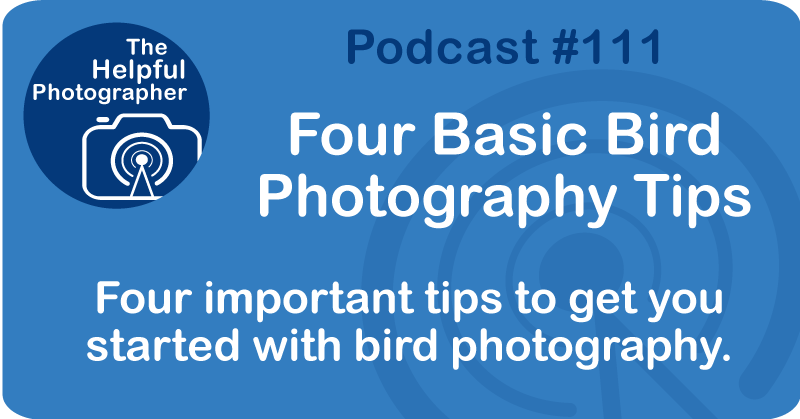Four Bird Basic Photography Tips #111
Four Bird Photography Tips #111

For those who know me, you know I'm definitely not a bird shooter. And I've said out loud that I will not under any circumstance get into bird watching. When I suggested to my husband that I download Merlin to my phone, my husband objected, saying, "Don't do it honey! It's the gateway app!" But alas, I spent my last couple of trips abroad shooting, you guessed it, birds. So here are some important things I learned while shooting birds, in no particular order.
To set the scene, in November, I was in Costa Rica specifically looking for birds. I was shooting a Canon 5D Mark IV with a Sigma 150 to 600 millimeter lens. Also note that I'm a right eye shooter. I say that because about 5% of the population seems to shoot with their left eye. The first thing I learned was that if I pointed at the bird while the lens was zoomed all the way to 600mm, it was very difficult to find the bird in my frame. I discovered that if I sighted the bird with my eyes and then put the camera to my right eye while still looking at it with my left eye, over 95% of the time I had it in my frame. So keep your eyes on the bird, bring the camera to your eye while keeping both eyes open. And BAM! There it is.
Okay. Number 2. A monopod. Although the 150-600mm lens is not gigantic, it is still big and heavy. And carrying and pointing that all day takes a toll on my back and neck, especially since very often I was shooting upwards. I found my monopod to be invaluable. The monopod allows you to take the weight off of your body both while you're shooting and while you're resting. I also found I'm starting to think that a gimbal or a tilt head would be better for bird photography. Another thing I found was that walking around with such a large lens was quite a chore. So I've decided to buy one of those chest harnesses for my lens. Although I didn't have it for this last trip, I've tried it out and I think it will work well for bird photography. My regular camera bag is a Think Tank Speed Freak. I love these bags, but unfortunately, they won't take all my gear for this kind of shooting. So I opted for a backpack. But it was exactly as I thought it would be. Every time I needed to change my lens, it was an entire event. And carrying the big lens on my side was really difficult. So next time, I'm going to use the chest harness with the 600 millimeter and also the 70 to 200 millimeter lens, and that is all I will carry for short distances.
Number three, spot metering. When people share their bird photos with me, I often see exposure problems. Mostly, the birds are extremely underexposed. The reason is because they are often dark and the photographer has shot the bird flying up in the bright sky and the bright sky has overwhelmed the exposure. The best way to overcome this is to wait until the bird is in front of a darker background. But sometimes, even when it's in a tree, it's still against a bright background. I came to find the best way to fix this problem is to use spot metering. By spot metering on the bird, the bird will be much closer to the right exposure. As most birds are on the dark side of the spectrum, they may even be a little bit overexposed, in which case you might want to exposure compensate a little negative. But don't forget, overexposing a little bit is better than under-exposing. The key problem I had with this was that my camera was only capable of spot metering in the dead center of my frame, so all of my compositions were centered. If you're shooting mirrorless, it is possible to tether your spot metering to your focus point, which is a huge benefit. Now, if you have a white bird, you will need to compensate a little bit positive when spot metering. But if you're spot metering on their eyes, which is pretty much always dark, you'll need to exposure compensate a little bit negative.
My last big takeaway is shutter priority versus manual. First of all, why not aperture priority or program? Because in both of those modes, the shutter speed is tied to your focal length, and if you have any motion, like a flying bird, then it's likely to require a faster shutter speed. So you really need to shoot in a mode that allows you to dictate the shutter speed. If the bird is sitting still, then at a minimum, your shutter speed needs to be 1 over your focal length. In other words, if you're shooting a 500mm lens, then your shutter speed should be 1/500 for a full frame sensor or 1/800 for an APS-C sensor, as you have to multiply the focal length times 1.6. If you anticipate the bird taking flight at all, you will need to be shooting at 1 over a thousand or faster. It all depends on the speed of the bird and your relative distance to the bird. I found that if I wanted to stop the action of a hummingbird's wings, I needed to be at 1/1250. And even then, it was a tad slow. But shooting at these fast speeds presents other problems. It is often the case the bird is not in great light, so your camera is going to have to open up the aperture to compensate for the fast shutter speed. And it is likely to do that before raising your ISO. And since one of the issues with shooting birds is getting that eyeball tack sharp, you'll need to nail that focus. But with a wide open aperture, this is going to be reasonably difficult. So it would be helpful to close down a couple of stops. In order to achieve this, you could set yourself to manual mode with the desired f-stop and shutter speed and put your ISO to auto and let the ISO land where it lands. Unfortunately, it's likely to go rather high, but it is what it is.
So that's what I got on bird photography. I'll let you know if I learn anything further next year.











